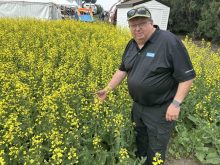Landowners in the Saskatchewan Rural Municipality of Caledonia remain concerned about the effects a proposed landfill could have on water, litter and the fate of a sharp-tailed grouse mating ground.
Public meetings held Jan. 20 in Milestone were limited, said Blaine Sudom, who speaks for those concerned about the project.
“We had asked if we could make a presentation of our concerns and we weren’t allowed to,” he said. “We thought the format of question and answer wasn’t really what we were looking for.”
Read Also

First annual Ag in Motion Junior Cattle Show kicks off with a bang
Ag in Motion 2025 had its first annual junior cattle show on July 15. The show hosted more than 20…
Loraas Disposal wants to construct a private landfill near Highway 334 in the RM of Caledonia adjacent to the RM of Elmsthorpe and a community pasture. The land is partially farmed now, by Sudom, and also contains the grouse mating ground next to the pasture.
Loraas held the meetings to discuss what general manager Curtis West had earlier said was misinformation.
West said after the meetings, which were guided by a professional moderator, that they “went as expected.”
“We are currently considering our options,” he said in an email.
Sudom said the company’s consultant said at the meetings that the site was suitable, but residents are still worried that it sits atop an aquifer and between two Moose Jaw River tributaries.
He said the company said it would build dikes to divert any water around the site and would also have liners or clay to prevent seepage into the aquifer.
“They said that, yes, there will be litter that will escape but they have equipment that can go out and pick litter,” Sudom said. “We wondered about that because of the pasture, whether that’s viable. It’s such rough ground.”
As for the grouse, Sudom said company officials said they would consult experts and see what could be done.
Many responses to questions were that the project is at a very early stage and probably three to four years away, he said.
“What we concluded is that under the environment act, under the self-assessment part of it, you have to have a public meeting and we think they kind of just checked the box off,” Sudom said.
The self-assessment is designed for proponents to assess their legal obligations for ministerial approval for a project, according to environment ministry documents.
The principles are to identify potential effects, evaluate them and plan ways to mitigate or enhance them.
After the self-assessment process, proponents can submit technical proposals if they decide to go ahead.
The concerned citizens garnered more than 1,000 names on a petition against the project. However, it carries no legal weight.
“Our major objective was to stop it from going through as a quick self-assessment and I think we probably accomplished that,” Sudom added. “I hope we have.”


















